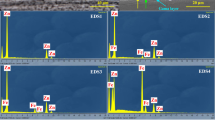Abstract
The characteristics of the prevention of electrolytic corrosion during micro electrical discharge machining (EDM) using deionized water and high frequency bipolar pulse were investigated. Electrolytic corrosion during micro EDM using deionized water was analyzed using an equivalent electrical circuit based on the electrical double layer theory. Based on the analysis and experimental verification, a narrow positive pulse duration should be provided to the workpiece to prevent corrosion. A negative voltage with zero average applied voltage (Vavg, app) is also essential for this purpose. If Vavg, app is positive or negative, electrolytic corrosion occurs on the workpiece or tool, respectively. Micro holes and 3D structures without corrosion were successfully fabricated using a high frequency bipolar pulse with a pulse duration of 0.2 μs and a period of 1 μs, as well as Vavg, app = 0 V.













Similar content being viewed by others
References
Bard AJ, Faulkner LR (2001a) Electrochemical methods: fundamentals and applications. Wiley, New York, p 102
Bard AJ, Faulkner LR (2001b) Electrochemical methods: fundamentals and applications. Wiley, New York, pp 98–99
Bard AJ, Faulkner LR (2001c) Electrochemical methods: fundamentals and applications. Wiley, New York, p 12
Bockris JO’M, Reddy AKN (1970) Modern electrochemistry, vol 2. Plenum, New York, p 877
Chung DK, Kim BH, Chu CN (2007) Micro electrical discharge milling using deionized water as a dielectric fluid. J Micromech Microeng 17:867–874
Chung DK, Shin HS, Kim BH, Park MS, Chu CN (2009) Surface finishing of micro-EDM holes using deionized water. J Micromech Microeng 19:045025
Chung DK, Shin HS, Park MS, Kim BH, Chu CN (2011a) Recent researches in micro electrical machining. Int J Precis Eng Manuf 12:371–380
Chung DK, Shin HS, Park MS, Chu CN (2011b) Machining characteristics of micro EDM in water using high frequency bipolar pulse. Int J Precis Eng Manuf 12:195–201
Chung DK, Shin HS, Kim BH, Chu CN (2011c) High frequency micro wire EDM for electrolytic corrosion prevention. Int J Precis Eng Manuf 12:1125–1128
de Abril O, Gundel A, Maroun F, Allongue P, Schuster R (2008) Single-step electrochemical nanolithography of metal thin films by localized etching with an AFM tip. Nanotechnology 19:325301
Kim BH, Ryu SH, Choi DK, Chu CN (2005) Micro electrochemical milling. J Micromech Microeng 15:124–129
Paik WK, Park SM (2001) Electrochemistry: science and technology of electrode processes (in Korean). Cheong Moon Gak, Seoul, p 53
Prentice G (1991a) Electrochemical engineering principles. Prentice-Hall International, New Jersey, p 94
Prentice G (1991b) Electrochemical engineering principles. Prentice-Hall International, New Jersey, p 112
Song KY, Chung DK, Park MS, Chu CN (2009) Micro electrical discharge drilling of tungsten carbide using deionized water. J Micromech Microeng 19:045006
Song KY, Chung DK, Park MS, Chu CN (2010) Micro electrical discharge milling of WC–Co using a deionized water spray and a bipolar pulse. J Micromech Microeng 20:045022
Uhlmann E, Piltz S, Doll U (2005) Machining of micro/miniature dies and moulds by electrical discharge machining—recent development. J Mater Process Technol 167:488–493
Xiaoping S, Spitzer P, Sudmeier U (2007) Novel method for bulk resistance evaluation in conductivity measurement for high-purity water. Accred Qual Assur 12:351–355
Yu ZY, Rajurkar KP, Shen H (2002) High aspect ratio and complex shaped blind micro Holes by micro EDM. Ann CIRP 51:359–362
Acknowledgments
This research was supported by the MKE (The Ministry of Knowledge Economy), Korea, under the Convergence-ITRC (Convergence Information Technology Research Center) support program (NIPA-2011 C6150-1101-0004) supervised by the NIPA (National IT Industry Promotion Agency) and supported by the National Research Foundation of Korea (NRF) grant funded by the Korea government (MEST) (No. 2010-0001201) and supported by the National Research Foundation of Korea (NRF) grant funded by the Korea government (MEST) (No. 2011-0000192).
Author information
Authors and Affiliations
Corresponding author
Rights and permissions
About this article
Cite this article
Chung, D.K., Shin, H.S. & Chu, C.N. Modeling and experimental investigation for electrolytic corrosion prevention in high frequency micro EDM using deionized water. Microsyst Technol 18, 703–712 (2012). https://doi.org/10.1007/s00542-012-1497-x
Received:
Accepted:
Published:
Issue Date:
DOI: https://doi.org/10.1007/s00542-012-1497-x




